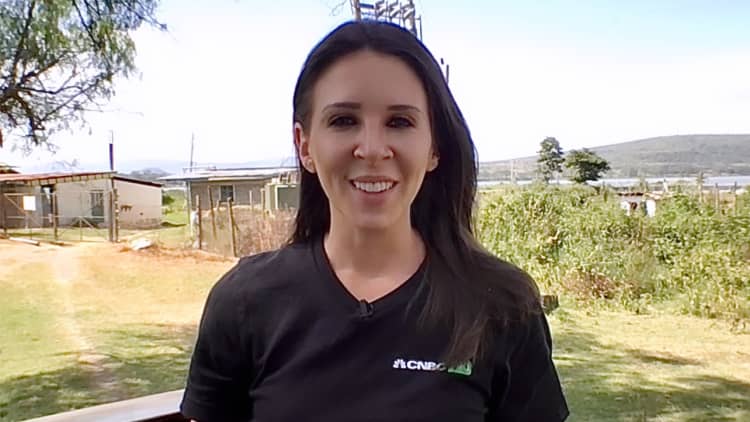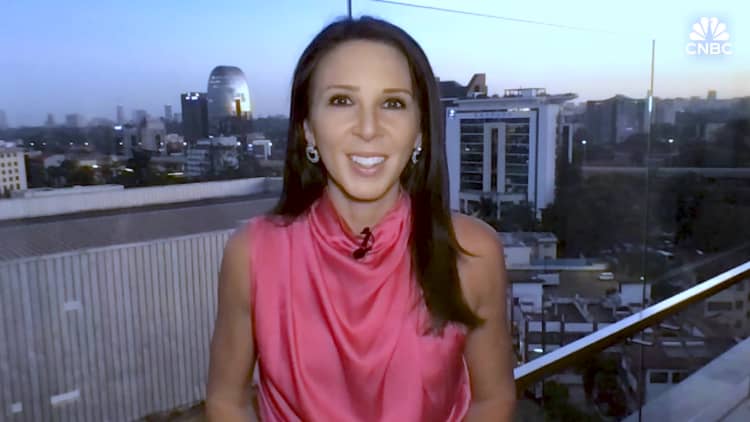
HELL’S GATE, Kenya — Two-and-a-half hours northwest of Nairobi by car, a small group of bitcoin miners set up shop at the site of an extinct volcano near Hell’s Gate National Park.
The mine, tucked away on the edge of Lake Naivasha, is operated by a startup called Gridless and consists of a single 500-kilowatt mobile container that, from the outside, looks like a small residential trailer.
Backed by Jack Dorsey’s Block, Gridless electrifies its machines with a mix of solar power and the stranded, wasted energy from a nearby geothermal site. It’s one of six mines run by the company in Kenya, Malawi and Zambia, powered by a mix of renewable inputs and working toward a broader mission of securing and decentralizing the bitcoin network.
Gridless runs Gridlesin Hell’s Gate operates on geothermal power.
MacKenzie Sigalos
“Most people think about bitcoin and the price of bitcoin and how they can save value in it or maybe spend it,” Gridless CEO Erik Hersman told CNBC during a visit to the Kenyan mine earlier this year. “That doesn’t happen without the bitcoin miners and us being globally distributed.”
Decentralization is a key feature of bitcoin, because it means the network isn’t controlled by any entity and can’t be shut down — even if a government disapproves.
Bitcoin and some other cryptocurrencies are created through a process known as proof-of-work, in which miners around the world run high-powered computers that collectively validate transactions and simultaneously create new tokens. The process requires heaps of electricity, leading miners to seek out the cheapest sources of power.
While there are more than a dozen publicly traded miners, thousands of smaller, private operations are also competing to process transactions and get paid in new bitcoin. That includes individual miners in countries from Venezuela to Lebanon, and can involve a single mining rig in a kitchen or several hundred thousand of them in an industrial-grade datacenter.
Gridless runs a geothermal-powered bitcoin mine in Hell’s Gate on the shore of Lake Naivasha.
MacKenzie Sigalos
Wherever the operation, bitcoin mining is a volatile business, because so much of the economics depends on the price of the cryptocurrency. Since losing 60% of its value in 2022, bitcoin has come roaring back, hitting a record above $73,000 in March, before pulling back a bit in recent weeks.
Much of the rally has been tied to the launch of spot bitcoin exchange-traded funds in the U.S., as well as optimism surrounding the so-called halving that took place late Friday. That event occurs every four years and is designed to cut the reward for bitcoin miners in half, reducing the pace at which new bitcoins enter the market. Prior halving events have been followed by big run-ups in the cryptocurrency.
“Bitcoin is effectively unbreakable at this point,” said Adam Sullivan, CEO of Core Scientific, a bitcoin miner based in Texas. “Bitcoin is at a point where it is more profitable to continue supporting the network than to try and break it.”
Analysts at Deutsche Bank wrote in a note on April 18 that they expect the geography of crypto mining to shift after the halving as slimmer profit margins force miners to seek cheaper and more reliable forms of energy. The analysts wrote that the U.S. currently accounts for 40% of mining, with Russia at 20% and China at 15%.
“Latin America, Africa and the Middle East have caught the attention of crypto miners due to their lower energy costs,” they wrote.
Bitfarms, based in Toronto, is now operating in Argentina, while Marathon Digital, headquartered in Florida, has expanded into the United Arab Emirates and Paraguay.
Hersman, 48, was raised in Kenya and Sudan, where his parents were linguists. Before getting into bitcoin mining, he and his two co-founders, Philip Walton and Janet Maingi, spent years building internet connectivity infrastructure in rural and urban Africa.
Gridless runs bitcoin mines in Kenya, Malawi, and Zambia on a mix of renewable energy sources. The company’s site in Hell’s Gate operates on geothermal power.
MacKenzie Sigalos
In early 2022, the trio began brainstorming creative solutions for the divide between power generation and capacity, and the lack of access to electricity in Africa. They landed on the idea of bitcoin mining, which could potentially solve a big problem for renewable energy developers by taking their stranded power and spreading it to other parts of the continent. In Africa, 43% of the population, or roughly 600 million people, lack access to electricity.
Gridless now has eight full-time staffers and manages much of its operations remotely with its software.
Turning lava into bitcoin
Hell’s Gate is a deep and winding canyon that is home to cheetahs, zebras, and giraffes and rimmed by cliffs, volcanoes and thick bush.
The area is covered in ash, and sulfuric plumes of steam will periodically emit from the ground, a reminder of the surrounding, smoldering volcanic craters that wiped out some of the native Maasai tribe in the mid-19th century and threatened others who dared to take up residence there.
Gone are the days of fatal eruptions and spewing lava. Instead, an elaborate, labyrinthine piping system and volcanic plugs comprise multiple geothermal power stations.
A drilling hole at the Olkaria geothermal power station in Hell´s Gate National Park.
Getty Images/Michael Gottschalk
Volcano-powered bitcoin mining isn’t new.
Iceland, El Salvador and other countries have been harnessing geothermal energy to mine bitcoin. To make the conditions work for miners, the businesses need the combination of a buy-in from local authorities, cheap and abundant power and some infrastructure, said Nic Carter, founding partner of Castle Island Ventures, which focuses on blockchain investments.
“If you have those three ingredients, it can work, but sometimes, it’s the nation state, or a national, state energy company doing it,” Carter said. He pointed to the Middle East, which is getting into flare gas mining as an example of state-level actors entering the business.
“In some cases, it’s with the explicit blessing of the nation state like Bhutan, and then in Texas, it’s just with very favorable local regulators and local conditions,” he said.
Africa is home to an estimated 10 terawatts of solar capacity, 350 gigawatts of hydro and another 110 gigawatts of wind.
Some of this renewable energy is being harnessed already, but a lot isn’t because building the specialized infrastructure to capture it is expensive. Even with 60% of the best solar resources globally, Africa only has 1% of installed solar PV capacity.
Enter bitcoin miners.
Bitcoin gets a bad rap for the amount of energy it consumes, but it can also help unlock these trapped renewable sources of power. Miners are essentially energy buyers, and co-locating with renewables creates a financial incentive to bolster production.
“As often happens, you’ll have an overage of power during the day or even at night, and there’s nobody to soak that power up,” said Hersman. He said his company’s 50-kilowatt mining container can “take up whatever is extra throughout the day.”
Steam tubes at the Olkaria geothermal power station in Hell´s Gate National Park.
Getty Images/Michael Gottschalk
“Within any second or minute, we are going up and down on a certain number of miners that are running,” Hersman said. “It might be down to 50 kilowatts, then up to 300 kilowatts, then down to 200 kilowatts, and then up to another level — and that will happen all day and all night.”
According to the International Energy Agency, in Africa’s rural areas, “where over 80% of the electricity-deprived live, mini-grids and stand-alone systems, mostly solar based, are the most viable solutions.”
Demand from bitcoin miners on these semi-stranded assets is making renewables in Africa economically viable. The power supplier benefits from selling energy that previously had been discarded, while the energy plants will sometimes lower costs for the customer. At one of the Gridless pilot sites in Kenya, the hydro plant dropped the price of power from 35 cents per kilowatt hour to 25 cents per kWh.
The buildout of capacity is also electrifying households.
Gridless says its sites have powered 1,200 houses in Zambia, 1,800 in Malawi and 5,000 in Kenya. The company’s mines also have delivered power for containerized cold storage for local farmers, battery charging stations for electric motorcycles and public WiFi points.
“It’s not really sexy,” Hersman said. “It’s a mining container made from a shipping container. It’s got a bunch of dumb machines sitting in it running the same equation over and over again, but it’s actually what secures the network.”

Read More: World News | Entertainment News | Celeb News
CNBC










